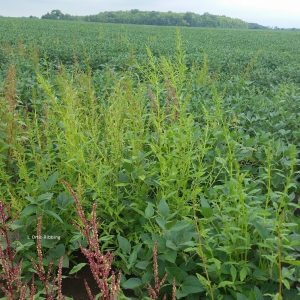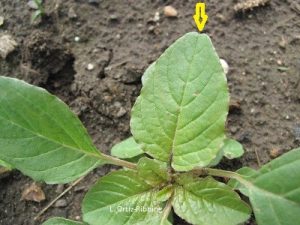Driving through Fond du Lac and Dodge Counties, it is obvious that many soybean fields have weed escapes, many of which are in the pigweed family (Photo 1). Wisconsin has several upright pigweeds that are common problems. These are redroot pigweed, smooth pigweed, and spiny pigweed. Unfortunately, it is also becoming home to two additional species (waterhemp and Palmer amaranth) that are much more competitive and difficult to control because they produce more seeds, germinate and emerge over a longer period of time, and readily evolve resistance compared to the other species.
Early season detection and identification is best for management options and preventing seed formation. Currently, these weeds are flowering and setting seed, and nothing short of a bean hook and pulling is going to remove them.
Help identify pigweed locations in WI.
In fact, UW-Extension wants your help. UW-Extension Weed Specialist Dr. Mark Renz is asking producers and homeowners to report a pigweed. The purpose of this program is to identify locations where these two problematic weeds (waterhemp and Palmer amaranth) exist. Palmer amaranth has not been identified in either Dodge or Fond du Lac County yet, but nearby counties that have positive finds include Waushara, Adams, Dane, Rock, Sauk, Iowa, and Grant Counties.
Be a first responder and report. Three things are needed: the location (address or GPS coordinates); the habitat (corn field, fencerow, garden, parking lot, etc.); and close-up photos of the plant’s stem, leaves, and leaf petioles to help confirm the identification. Additionally, if you feel you have a herbicide resistant population, please feel free to include any pertinent information such as the name of the herbicide(s) used that showed limited control.
Pigweed identifying features.
Proper identification is important and can be simple and easy. First, make sure the plant is a pigweed. Weeds in the pigweed or Amaranthus family are summer annuals. The tip end of the leaf, especially when the plant and leaves are small, typically has a slight notch (Photo 2). Second, look at the stems. Redroot and smooth pigweeds have hairs on their stems. Redroot pigweed is more hairy than smooth pigweed. If the stems are smooth, then you have either waterhemp, Palmer amaranth, or spiny amaranth. As the name implies, spiny amaranth has stiff spines on the stem where the leaf attaches to the stem. You will feel them. That will exclude spiny amaranth.
While both waterhemp and Palmer amaranth have smooth stems, the third distinction is to look at leaf petioles. The petiole is the thin stalk that attaches the leaf’s blade to the plants stem. Bend the petiole back across the leaf. The petioles on Palmer amaranth are longer than the leaf blade. Waterhemp leaves are elongated and its petiole does not extend beyond the tip of the leaf.
How to report.
Report by sending the location, habitat, and send close-up plant photos either by email at reportapigweed@gmail.com or by the Great Lakes Early Detection Network (GLEDN) app. App instructions are available at: https://fyi.extension.wisc.edu/wifdn/files/2017/01/GLEDN-App-Guide.pdf.
More reporting information and videos are at: https://fyi.extension.wisc.edu/wifdn/report-a-pigweed/
For more information about pigweed identification contact, Dr. Loretta Ortiz-Ribbing, the UW-Extension Crops & Soils Area Agent for Fond du Lac and Dodge Counties at Loretta.OrtizRibbing@ces.uwex.edu or call the Fond du Lac or Dodge County Extension Offices.
Photo 1: Waterhemp in soybean field (Photo Credit: L. Ortiz-Ribbing)
Photo 2: Pigweed leaf showing notch in leaf tip (Photo Credit: L. Ortiz-Ribbing)





